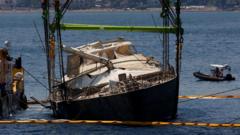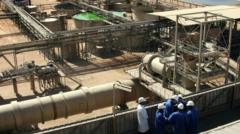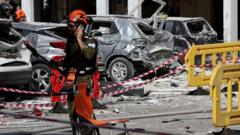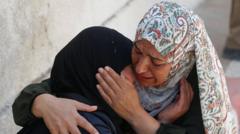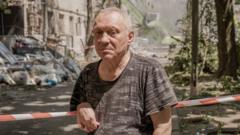This article dives into the staggering statistics of Russian military casualties in Ukraine, reflecting on the relentless front-line struggles, recruitment tactics, and the implications of these losses on future conflicts.
**Russian Losses Surge in Ukraine: A Cost of 27 Lives per Kilometre**
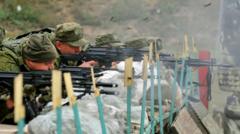
**Russian Losses Surge in Ukraine: A Cost of 27 Lives per Kilometre**
An alarming report reveals that Russia's military casualties in Ukraine have dramatically increased, with losses totaling over 45,000 in 2024 alone.
In 2024, Russian forces experienced their highest casualty rates since the onset of the full-scale war in Ukraine, with at least 45,287 soldiers killed. This figure marks almost a threefold increase compared to the previous year and significantly exceeds the losses recorded in 2023. As the front line advanced throughout the year, data indicates that for every kilometre of Ukrainian territory captured, Russia lost approximately 27 soldiers.
This analysis, conducted by the BBC Russian Service in partnership with Mediazona and volunteers, meticulously compiled open-source data from various sources such as military memorials and obituaries. It identifies the names of 106,745 soldiers confirmed dead during the invasion, although experts believe the true toll may be 164,223 to 237,211, covering a substantial portion of unrecorded casualties.
One particularly harrowing date, February 20, 2024, marked the deadliest day for Russian troops, resulting in 201 deaths when a Ukrainian missile strike targeted a training ground in Volnovakha. Among those lost were Aldar Bairov, Okhunjon Rustamov, and Igor Babych, all members of the 36th Motorised Rifle Brigade, highlighting the individual stories behind the statistics.
In previous years, Russian losses fluctuated, typically rising during intense battles—such as those for key cities like Bakhmut—followed by periods of relative calm. However, 2024 did not exhibit this trend, as heavy fighting continued without significant dips in casualties, largely driven by intense battles around Avdiivka and Robotyne.
Additionally, tactical changes in combat strategy have contributed to elevated fatalities. The American Institute for the Study of War (ISW) points to a pattern of repeated assaults which, though territorially successful, have come at a severe human cost, with tens of thousands of soldiers perishing even as substantial ground was gained.
Recruitment strategies have shifted in response to these heavy losses. In late 2024, Russian military recruitment surged, reportedly exceeding the number of casualties. This included increased financial incentives for soldiers, effectively raising combat salaries far above the average regional wage. Many volunteers, who made up a significant portion of the casualty statistics, received minimal training before being deployed, drastically reducing their survival chances.
Bashkortostan has emerged as the region with the highest casualty counts, predominantly from rural backgrounds, where 38% of soldiers fought with no prior military experience. Observations suggest that the death toll could be higher when considering soldiers who are still unaccounted for.
As the war continues and casualties mount, the analysis emphasizes the ongoing challenges faced by the Russian military, the rising numbers of families affected by these losses, and the critical view of Russia's combat strategies moving forward.
This analysis, conducted by the BBC Russian Service in partnership with Mediazona and volunteers, meticulously compiled open-source data from various sources such as military memorials and obituaries. It identifies the names of 106,745 soldiers confirmed dead during the invasion, although experts believe the true toll may be 164,223 to 237,211, covering a substantial portion of unrecorded casualties.
One particularly harrowing date, February 20, 2024, marked the deadliest day for Russian troops, resulting in 201 deaths when a Ukrainian missile strike targeted a training ground in Volnovakha. Among those lost were Aldar Bairov, Okhunjon Rustamov, and Igor Babych, all members of the 36th Motorised Rifle Brigade, highlighting the individual stories behind the statistics.
In previous years, Russian losses fluctuated, typically rising during intense battles—such as those for key cities like Bakhmut—followed by periods of relative calm. However, 2024 did not exhibit this trend, as heavy fighting continued without significant dips in casualties, largely driven by intense battles around Avdiivka and Robotyne.
Additionally, tactical changes in combat strategy have contributed to elevated fatalities. The American Institute for the Study of War (ISW) points to a pattern of repeated assaults which, though territorially successful, have come at a severe human cost, with tens of thousands of soldiers perishing even as substantial ground was gained.
Recruitment strategies have shifted in response to these heavy losses. In late 2024, Russian military recruitment surged, reportedly exceeding the number of casualties. This included increased financial incentives for soldiers, effectively raising combat salaries far above the average regional wage. Many volunteers, who made up a significant portion of the casualty statistics, received minimal training before being deployed, drastically reducing their survival chances.
Bashkortostan has emerged as the region with the highest casualty counts, predominantly from rural backgrounds, where 38% of soldiers fought with no prior military experience. Observations suggest that the death toll could be higher when considering soldiers who are still unaccounted for.
As the war continues and casualties mount, the analysis emphasizes the ongoing challenges faced by the Russian military, the rising numbers of families affected by these losses, and the critical view of Russia's combat strategies moving forward.

